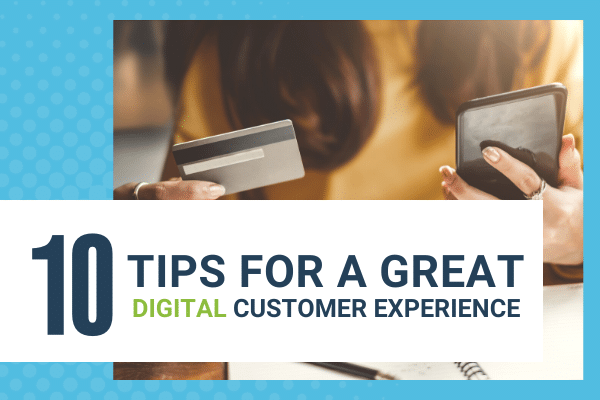You’ve heard about customer experience, but how does this translate online? We’re living in a digital world, so it should come as no surprise that we also have to define digital customer experiences for our audiences. More importantly, what do today’s customers expect in a digital customer experience?
To answer this question fully, we first need to define digital customer experience. This refers to the total online interactions a customer has with your brand. This includes things like your website, social media presence, chatbots, and other virtual touchpoints. Essentially, every time you use digital tools to communicate with customers, you’re drawing upon the customer experience.
Your goal is to create an experience that’s seamless and memorable. You want customers to walk away from every interaction feeling great about your brand. This is how you turn passive customers into superfans. However, it doesn’t happen out of nowhere. The right digital customer experience takes strategy and know-how. When your customers are invested emotionally in your success, they have a significantly greater lifetime value.
Do you know what your consumers really want when it comes to CX? Remember customers today don’t see the digital customer experience as something separate from your in-person interactions. This is simply another way to connect with customers.
Though it’s easy to assume you know what customers think, don’t get in the habit of putting words in their mouths. What is that customers really want when it comes to the digital customer experience? Luckily the answer might be more straightforward than you think. In this guide, we’ll share 10 things consumers expect in a digital customer experience.
- 1. Build an Omnichannel Experience
- 2. Personalize Interactions
- 3. Survey Customers to Get Feedback
- 4. Act on Customer Feedback
- 5. Stay Transparent About Data Privacy
- 6. Engage on Social Media
- 7. Offer Self-Service Support
- 8. Make Purchasing Convenient
- 9. Focus on Mobile-First Design
- 10. Always Look for Innovative Ideas
1. Build an Omnichannel Experience
To begin, customers want consistency. Though it might sound simple (because it is), 90% of consumers expect consistent experiences across all channels. However, only 29% of audiences actually agree this happens. There’s often a disconnect, whether intentional or accidental.
Today, it’s not good enough to have a great mobile experience or a great in-store experience. Everything needs to be streamlined and effortless across the board. There are no shortcuts. This is an opportunity to shape your brand into a digital powerhouse. This is called an omnichannel experience, and it’s one of the leading customer engagement trends.
What does “omnichannel experience” mean? It’s when customers use different channels (in-store, social media, website, etc.) to interact with a brand. Your goal as a brand is to provide a seamless, effortless cross-medium experience. Each customer touchpoint should be meaningful, intentional, and simplified. Whether a customer contacts the brand via chat, email, or in-person, they want to have a great interaction.
2. Personalize Interactions
Next, your customers are smarter than ever before. They no longer want to feel like a number on a screen or a sales transaction. They’re humans with their own experiences, interests, and challenges. In other words, they want to feel heard and understood.
By providing personalized experiences across the board, you show that you really care about your customers’ needs. You have their best interest at heart, and you know how to make each touchpoint count. This builds trust long-term, translating to more revenue and increased purchases. With 80% of customers more likely to purchase from brands with a personalized experience, don’t settle for one-size-fits-all.
How do you create a personalized digital customer experience? One of the best ways is to segment your shoppers. This means understanding exactly who you’re marketing to as well as what they expect in an experience. From recommending products customers actually want based on past purchases to sending targeted emails, every detail adds up. A CRM is one of the many tools that can help you segment your customers and track their preferences.
3. Survey Customers to Get Feedback
With that in mind, how can you know how to improve if you don’t ask customers directly? Your customers bring their own experiences, expectations, and backgrounds to each interaction. There is no single monolith, but you can still learn from their feedback.
Make it a priority to solicit feedback not just every once in a while, but after every key interaction. Some digital feedback opportunities include:
- After making a purchase
- After a sales chat/email message
- At the bottom of a blog post
- After a help guide
- When a user clicks away from a specific page
There’s no such thing as too much feedback. Your customers already have opinions, but they’re not likely to bring them up on their own. You need to do the heavy lifting to make this line of communication open throughout the digital journey. Did you know 53% of shoppers believe their feedback doesn’t actually go to anyone who acts on it? This means feedback is an essential piece of the puzzle, but it’s not the only piece.
4. Act on Customer Feedback
Additionally, it’s not enough to ask for feedback. That’s a great first step, but it can’t be your only step. You also need to have a plan to act on this customer feedback, creating real-world change. Most people want their opinions to be heard. When they see a company take their concerns or suggestions seriously, they take notice.
Again, it’s all about brand loyalty. Customers are more likely to trust brands that they feel have their backs. If you can listen and act on these ideas, you don’t have to worry about the competition. This is one of the biggest things consumers want in a digital customer experience.
What customer feedback should you act on? First, categorize the feedback. Is your feedback related to price, quality, service, or so on? From there, you can analyze your feedback to find outliers. Are there any demographic trends or channel-specific concerns? This allows you to dig deeper, turning passive feedback into active progress.
5. Stay Transparent About Data Privacy
However, it wouldn’t be a post about digital experiences without touching on data privacy. It seems like every day there’s a new story about a brand whose data was leaked somehow. Privacy and transparency can no longer be an afterthought. It’s up to you to put your customers’ data first.
Even when things happen (and sometimes they will), don’t wait to own up to your mistakes. Playing the blame game never wins you any superfine. Instead, be transparent and clear. Communicate how you’ll improve in the future and what went wrong. People appreciate honesty, especially online.
Unfortunately, we live in a digital age where a reported 45% of Americans have had their personal information compromised in the past 5 years. This means privacy needs to come first, and you need to be clear about how you protect your users’ data. You want to earn their trust. That takes time and transparency.
6. Engage on Social Media
Another important way to connect with users through the digital experience is to engage on social media. Though it sounds simple, many brands fall into the trap of posting and ghosting. This means they post something and then disappear from the platform, never to be seen again until they post something else in a few days or weeks.
This comes across as spammy, and it doesn’t leave a good impression. Instead, you want to become a member of your audience’s community. This means engaging with other users, sharing content, and being an active player in your digital space. When customers share user-generated content, you need to engage with that content and make them feel seen. Everyone wants to feel heard, especially online.
Your digital presence is an opportunity to let your brand voice shine. Whether you share behind-the-scenes videos on TikTok or you’re always the first to share tagged images, users take notice. More importantly, you’ll be top-of-mind when they think of your industry. Create a social media engagement plan today and make sure it’s working for your brand.
7. Offer Self-Service Support
Next, self-service is becoming the new normal in the digital age. When customers run into issues, they expect support—and they expect it immediately. In fact, 75% of customers list a fast response time as the most important aspect of a positive digital customer experience.
With that in mind, what is customer self-service support? This is when you provide support online without actually requiring any interaction with your support team. Customers expect solutions faster than ever, and it’s never been easier to make these solutions possible on their own. Self-service support comes in many forms, many of which you’re probably familiar with:
- Support videos
- FAQs
- Knowledge bases
- Online discussion forums
- Tutorials
Many of your lower-level customer support concerns can likely be solved through self-service solutions. Things like shipping questions, navigation challenges, and so on can all be handled through self-service. This saves you resources when it comes to your team’s time and energy, and it reduces your overall response time.
8. Make Purchasing Convenient
Whenever you’re providing a purchase experience online, you need to make it as frictionless as possible. Just look at any of today’s top online retailers. Platforms like Amazon, Nordstrom, and Target make it easy for customers to quickly check out items and get them shipped to their door.
This doesn’t just apply to retail businesses. Service-based businesses also are adapting to today’s digital customer experience demands. This means making it easy for users to schedule appointments, calls, and services online. The easier it is for users to make a purchase decision, the more likely they’ll convert.
How can you make purchasing more convenient? Allowing mobile wallets, multiple payment options, and seamless delivery are all the new normal. The retail giant Amazon was the first to change the game of digital checkout with their patented one-click shopping, but this is something you can replicate for yourself. Make the shopping experience as simple as possible for your customers and you’re on the right track. The more customers have to think their way through a check-out or booking screen, the more likely they’ll click away.
9. Focus on Mobile-First Design
Another important step for businesses today is to create a mobile-first design. In this day and age, we’re all attached to our mobile devices. This has changed the way we interact with websites and businesses alike. Over 54% of all website traffic worldwide last year was from a mobile device. This is a stat you can’t afford to ignore.
We can all relate to the frustration of navigating to a website on a mobile device only to run into formatting issues. It’s essential for your content to be legible and usable on all screen sizes. Any mobile-first designer will tell you the importance of creating a design focused on the hierarchy of information. In other words, your most important content should always be first (important links, CTAs, etc.).
Now is the time to take inventory of your current website design. Does it appear properly on all devices? Most modern web designers are adaptable for all screen sizes, but you should always do your own testing. You don’t need complex tech skills or programs to accomplish this. All it takes is a bit of time, some patience, and potentially some web design expertise.
10. Always Look for Innovative Ideas
Last but not least, always be on the lookout for innovative ideas. There’s no such thing as being too comfortable when it comes to your digital customer experience. The best companies today know the importance of staying light on your feet. If there’s one thing we can learn from the COVID19 pandemic, it’s that you can never be too comfortable.
It’s easy to feel overwhelmed with the sheer number of digital channels online nowadays. The more seamless the experience is across the board, the more adaptable your business becomes. Things change quickly. What worked in the past isn’t guaranteed to work in the future. If you suspect a change on the horizon, now is the time to take action.
With 32% of customers willing to stop doing business with a brand after just one bad experience, why risk your superfans? This doesn’t have to be complicated. The most important things consumers want aren’t complicated: speed, knowledge, friendly service, and convenience. The rest takes care of itself.
Are you ready to turn your passive customers into raving fans? If so, make sure these 10 things consumers want in a digital customer experience are at the forefront of your to-do list.





